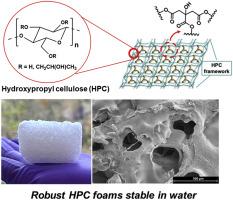Our official English website, www.x-mol.net, welcomes your
feedback! (Note: you will need to create a separate account there.)
Biopolymer Foams Composed of Hydroxypropyl Cellulose: Fabrication, Aqueous Stability, and Mechanical Integrity
Polymer ( IF 4.1 ) Pub Date : 2024-11-17 , DOI: 10.1016/j.polymer.2024.127817 Jordan Varma, Isha Farook, Jianxun Cui, Eva Morgenthaler, Caitlin Bien, Tiffany Yu, Dorin Preda, W. John Kidd, David Gamliel, Todd Emrick
Polymer ( IF 4.1 ) Pub Date : 2024-11-17 , DOI: 10.1016/j.polymer.2024.127817 Jordan Varma, Isha Farook, Jianxun Cui, Eva Morgenthaler, Caitlin Bien, Tiffany Yu, Dorin Preda, W. John Kidd, David Gamliel, Todd Emrick

|
We describe the fabrication of biopolymer foams formed from aqueous solutions of hydroxypropyl cellulose, whereby freezing-induced phase-separation and solvent removal yields robust foam structures that are elastic in air and when wet, and that are stable to repeated compression when fully saturated with water. Through mechanisms of phase-separation, pore formation, and covalent crosslinking, we discovered effective methods to prepare microporous HPC foams that resist gelation even when exposed to water for long time frames (at least months). Employing multifunctional carboxylic acid crosslinkers allowed the foams to maintain their integrity when dry or wet, while the presence of α-cellulose as an additive further augmented their mechanical integrity and provided a means to adjust elasticity. The amount of crosslinker employed in the foaming process significantly impacted foam stability and water uptake, while polymeric crosslinkers enabled insertion of sulfobetaine zwitterionic moieties into the foams. Notably, the thermal transition characteristic of HPC solutions and gels proved operative in foam form, as seen in release of water from a saturated HPC foam using a combination of compressive and thermal mechanisms.
中文翻译:

由羟丙基纤维素组成的生物聚合物泡沫:制造、水性稳定性和机械完整性
我们描述了由羟丙基纤维素水溶液形成的生物聚合物泡沫的制造,其中冷冻诱导的相分离和溶剂去除产生了坚固的泡沫结构,这些结构在空气中和潮湿时具有弹性,并且在完全饱和时对重复压缩保持稳定。通过相分离、孔形成和共价交联机制,我们发现了制备微孔 HPC 泡沫的有效方法,即使长时间(至少几个月)暴露在水中也能抵抗凝胶化。使用多功能羧酸交联剂使泡沫在干燥或潮湿时都能保持其完整性,而 α-纤维素作为添加剂的存在进一步增强了它们的机械完整性,并提供了一种调节弹性的方法。发泡过程中使用的交联剂的量显着影响了泡沫稳定性和吸水率,而聚合物交联剂使磺基甜菜碱两性离子部分能够插入泡沫中。值得注意的是,HPC 溶液和凝胶的热转变特性被证明在泡沫形式下起作用,如使用压缩和热机制的组合从饱和 HPC 泡沫中释放水所见。
更新日期:2024-11-18
中文翻译:

由羟丙基纤维素组成的生物聚合物泡沫:制造、水性稳定性和机械完整性
我们描述了由羟丙基纤维素水溶液形成的生物聚合物泡沫的制造,其中冷冻诱导的相分离和溶剂去除产生了坚固的泡沫结构,这些结构在空气中和潮湿时具有弹性,并且在完全饱和时对重复压缩保持稳定。通过相分离、孔形成和共价交联机制,我们发现了制备微孔 HPC 泡沫的有效方法,即使长时间(至少几个月)暴露在水中也能抵抗凝胶化。使用多功能羧酸交联剂使泡沫在干燥或潮湿时都能保持其完整性,而 α-纤维素作为添加剂的存在进一步增强了它们的机械完整性,并提供了一种调节弹性的方法。发泡过程中使用的交联剂的量显着影响了泡沫稳定性和吸水率,而聚合物交联剂使磺基甜菜碱两性离子部分能够插入泡沫中。值得注意的是,HPC 溶液和凝胶的热转变特性被证明在泡沫形式下起作用,如使用压缩和热机制的组合从饱和 HPC 泡沫中释放水所见。


















































 京公网安备 11010802027423号
京公网安备 11010802027423号